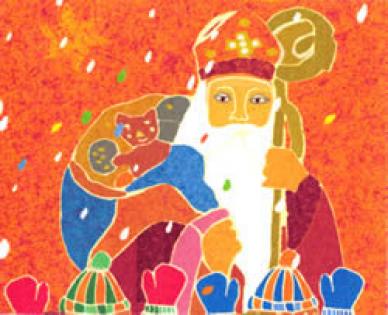St Nicholas’ Day – 6th December – heralds the day we can start talking about Christmas without it feeling as if it’s all too soon, because it is with St Nicholas that the story of Santa Claus begins.
The real Nicholas was born in the 3rd Century in a Greek village that is now part of southern Turkey. Young Nick’s wealthy parents died when he was still young and, being a devout follower of Jesus Christ, Nicholas used his entire inheritance to assist those in need financially and who were in poor health. Throughout his life, he became known for protecting and helping those in need, and a protector of children.
Eventually, he was made a Bishop of the Christian Church (which, at the time, was just one Church), because of his many good works over a lifetime which included a period in prison when Christians were being persecuted by the Roman Empire. Nicholas died on 6th December 343 and the anniversary of his death became St Nicholas’ Day, a day of celebration.
So how did St Nicholas metamorphose into Santa Claus?
Nicholas had long been remembered by many Europeans who continued to place food and other offerings in his memory on 6th December.
But the transformation came after the American War of Independence in the later part of the 18th century. New Yorkers wanted to get back to their Dutch heritage and St Nicholas was named patron saint of the city by John Pintard, the founder of the New York historical society. In 1810, Pintard commissioned an artist to depict St Nicholas who was shown in a gift-giving role with children’s treats in stockings hanging at a fireplace.
The cultural transformation which took place in America throughout the 19th Century resulted in a representation of St Nicholas that became the Santa we recognise today. This started with an anonymous poem in 1821 that talked of a figure referred to as ‘Sante Claus’ or ‘Sankt Niklaus’ who rewarded good behaviour, punished bad behaviour and gave gifts that were safe toys and books. The poem that we know as The Night Before Christmas was written in 1823 and originally entitled A Visit from St Nicholas which described his outfit as being
“ .... dressed all in fur, from his head to his foot
And his clothes were all tarnished with ashes and soot,
He had a broad face and a little round belly
That shook, when he laughed like a bowlful of jelly.
He was chubby and plump, a right jolly old elf ...”
This portrayal helped entrench a secular ‘Santa Claus’ tradition with the New York elite of gift giving to children and a happy family festivity. Santa was even portrayed as supporting President Lincoln and the Union during the American Civil War.
By the end of the 1920s, the Santa we know today - of a jolly, real life figure in a red, fur-trimmed suit - had formed. Once Coca-Cola started using Santa in advertisements from 1931, he was established as an icon of contemporary culture. As is the American way, Santa Claus was exported around the world and has become conflated with St Nicholas in the ensuing 80 years.
Nonetheless, despite the commercialisation attached to the festive season today, the concept of Santa Claus is also representative of St Nicholas and all he stood for: kindness, generosity, helping the needy and a protector of children – a model of how we should all live as well as the truly ‘good life’ espoused by Jesus Christ.
So welcome to the festive season for 2013! We hope you enjoy it with your family, friends - and us!
Peace and joy to all.


















__small.png)










